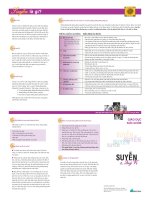Tài liệu Long Shot ppt
Bạn đang xem bản rút gọn của tài liệu. Xem và tải ngay bản đầy đủ của tài liệu tại đây (1.13 MB, 315 trang )
LONG SHOT
LONG SHOT
vaccines for national defense
K enda ll Hoyt
h arva r d u n i versity pr ess
Cambridge, Massachusetts
London, England 2012
Copyright © 2012 by the President and Fellows of Harvard College
All rights reserved
Printed in the United States of America
Library of Congress Cataloging-in-Publication Data
Hoyt, Kendall, 1971–
Long shot : vaccines for national defense / Kendall Hoyt.
p. ; cm.
Includes bibliographical references and index.
ISBN 978-0-674-06158-3 (alk. paper)
1. Vaccination—United States. 2. Vaccines—Government policy—United States.
3. Biological weapon—Safety measures—Government policy—United States. I. Title.
[DNLM: 1. History, 20th century—United States. 2. Vaccines—history—United
States 3. Biological Warfare Agents—United States. 4. Security Measures—United
States. QW 11 AA1]
RA638.H69 2011
614.4'7—dc23 2011026672
For Eli and Rhys
Contents
Introduction 1
1 Disease, Security, and Vaccines 11
2
Historical Patterns of Vaccine Innovation 32
3 Vaccine Development during World War II 49
4 Wartime Legacies 81
5 The End of an Era 110
6 Biodefense in the Twenty-First Century 142
7 The Search for Sustainable Solutions 160
Appendices
Vaccine License Data, 1903–1999 180
Developmental History of Vaccines
Licensed in the United States, 1903–1999 230
Military Contributions to Licenses
Representing Innovative Activity 244
Notes 251
A
cknowledgments 287
Index 289
Text Acronyms
ADM Advanced Development and Manufacturing
AEB Army Epidemiology Board
AEI American Enterprise Institute
AFEB Armed Forces Epidemiology Board
AMS Army Medical Graduate School
ARTP Army Specialized Training Units
BARDA Biomedical Advanced Research and Development Authority
BICIED Board for the Investigation and Control of Influenza and
other Epidemic Diseases
B
IO Biotechnology Industry Organization
BLA Biologic License Application
BOB Bureau of Biologics
BW Biological Weapons
BWC Biological Toxin and Weapons Convention
CDC Centers for Disease Control
CBER Center for Biologics Evaluation and Research
cGMP Current Good Manufacturing Practices
CHPPM Center for Health Promotion and Preventive Medicine
CMR Committee on Medical Research
CWS Chemical Warfare Service
DARPA Defense Advanced Research Projects Agency
DHS Department of Homeland Security
DMAT Disaster Medical Assistance Team
DMS Division of Medical Sciences
DOD Department of Defense
DOE Department of Energy
DTRA Defense Threat Reduction Agency
EPA Environmental Protection Agency
EPICON Epidemiological Consultation
x Text Acronyms
FDA Food and Drug Administration
FOIA Freedom of Information Act
FFRDC Federally Funded Research and Development Center
GOCO Government Owned Company Operated
GMP Good Manufacturing Practices
HHS Health and Human Services
IND Investigational New Drug
IOM Institute of Medicine
IP Intellectual Property
JDO Joint Development Office
JVAP Joint Vaccine Acquisition Program
LSI Lead System Integrator
MAP Molecular Anatomy Program
MCM Medical Countermeasure
NAS National Academy of Sciences
NASA National Aeronautics and Space Administration
NBSB National Biodefense Science Board
NCI National Cancer Institute
NDRC National Defense Research Committee
NHSS National Health Security Strategy
NIAID National Institute for Allergy and Infectious Diseases
NIE National Intelligence Estimate
NIH National Institutes of Health
NRC National Research Council
NSC National Security Council
OSRD Office of Scientific Research and Development
OSS Office of Strategic Services
OTA Office of Technology Assessment
PAHPA Pandemic All-Hazards Preparedness Act
PhRMA Pharmaceutical Research and Manufacturers Association
PHEMCE Public Health Emergency Medical Countermeasures
Enterprise
PHS Public Health Service
PPP Public Private Product Development Partnership
RFP Request for Proposals
SAB Science Advisory Board
SARS Severe Acute Respiratory Syndrome
SGO Surgeon General’s Office
SNS Strategic National Stockpile
UPMC University of Pittsburgh Medical Center
USAMRIID U.S. Army Medical Research Institute for Infectious
Diseases
U
NSCOM United Nations Special Commission
VRC Vaccine Research Center
VTEU Vaccine Treatment and Evaluation Unit
WBC War Bureau of Consultants
Text Acronyms xi
WHO World Health Organization
WRAIR Walter Reed Army Institute of Research
WRS War Research Service
Archive Acronyms
AP Aventis Pasteur Archives, Swiftwater, PA
MA Merck Archives, Whitehouse Station, NJ
NA National Archives, University of Maryland, College
Park, MD
N
AS National Academy of Sciences, Committee on Biological
Warfare Files, Washington, DC
L
C Library of Congress, Vannevar Bush Papers,
Washington, DC
W
R Walter Reed Army Institute of Research, Joseph Smadel
Reading Room Collection, Silver Spring, MD
LONG SHOT
Introduction
A m er ic a fac ed a hos t of biological threats to health
and security at the turn of the twenty-first century. Between 1990
and 2009, the United States contended with a foreign biological
weapons program, bioterrorism, and a pandemic. Concerns about
Saddam Hussein’s biological weapon caches sent the U.S. military
scrambling to immunize troops against smallpox and anthrax. The
2001 anthrax attacks demonstrated that non-state actors could ter-
rorize civilian populations with biological weapons as well. A strange
outbreak of severe acute respiratory syndrome (SARS) in 2002 and
new avian and swine flu strains provided further reminders of the
pandemic potential of infectious diseases.
While each individual threat posed limited danger to the nation,
together they raised awareness of the catastrophic potential of dis-
ease and spurred large-scale government demand for vaccines to
defend soldiers and civilians. Even so, only one new biodefense vac-
cine was licensed during this period. Many candidates were techno-
logically feasible and well funded. A next generation anthrax vaccine,
for example, has been a top priority for the U.S. government since
the first Gulf War, but twenty years and over a billion dollars later,
the United States still does not have this new vaccine.
2 Long Shot
These vaccine development failures are startling. The United
States was once capable of mounting rapid development campaigns
in response to national emergencies. World War II–era programs
generated ten new or improved vaccines against diseases of mili-
tary significance. In some cases, these programs produced new vac-
cines in time to meet the objectives of specific military operations.
Botulinum toxoid, for example, was mass-produced before D-day in
response to (faulty) intelligence that Germany had loaded V-1 bombs
with the toxin, and a Japanese encephalitis vaccine was developed in
anticipation of an Allied land invasion of Japan.
The ability to develop new vaccines quickly is essential to na-
tional security and public health. As biological threats proliferate
and new diseases continue to emerge, we have an urgent need to
understand the conditions that foster timely innovation. Present-
day vaccine programs tinker with push and pull policies (such as
research grants or market guarantees) to spur innovation, but they
rarely scrutinize the development process itself to address critical
obstacles to innovation. Long Shot examines the developmental his-
tory of vaccines to uncover the conditions that first drove, and later
inhibited, vaccine innovation.
This historical investigation provokes important questions for
today: What factors foster timely vaccine innovation? What are
the dynamics of industrial decision making during national secu-
rity crises? How can we generate innovation for medicines that
are socially valuable but commercially unappealing? How have
military-industrial partnerships changed, and why does this mat-
ter for vaccine development? And finally, how can history in-
form efforts to rebuild biodefense capabilities in the twenty-first
century?
v
S e c u r i t y e x p e r t s o f t e n refer to disease as a “non-
traditional” threat, but few security threats are more traditional
than disease. For the military, fighting disease has always been
an important corollary to fighting the enemy. History is rife with
battles in which bugs played a larger role than bullets.
1
Whether
at peace or at war, military settings encourage high rates of dis-
ease. Military camps breed new diseases and magnify the effects of
common diseases. Armed conflict exacerbates these conditions, pro-
ducing social dislocations and generating populations of wounded
and stressed individuals that boost the incidence and spread of
d
isease.
2
Intentional disease threats are equally “traditional.” Armies have
employed rudimentary forms of biological warfare since antiquity,
when retreating soldiers would contaminate enemy wells with hu-
man and animal corpses.
3
In the Middle Ages, Tartar invaders gained
notoriety for catapulting plague-infected corpses over city walls.
4
By the mid-twentieth century, delivery methods had improved con-
siderably as the United States, the Soviet Union, the United King-
dom, France, and Japan all invested in biological weapons programs.
The United States suspects that countries such as China, Russia,
Iran, Syria, Cuba, and North Korea have made more recent invest-
ments.
5
Several cults (the Rajneeshees and Aum Shinrikyo) and terrorist
groups (al-Qaeda) have demonstrated an interest in biological weap-
ons as well. While these non-state actors have had limited success,
past performance is not predictive of future outcomes. Biological
weapons will remain inherently attractive to dissatisfied groups
seeking asymmetric advantages because these weapons are less ex-
pensive and more difficult to trace than nuclear weapons. Over time,
supply will grow to meet demand as the economic, technical, and
educational obstacles continue to erode.
Opportunities for natural diseases to emerge and spread are
increasing as well. Population growth, climate change, and expand-
ing travel and trade patterns create new opportunities for disease.
The widespread use and misuse of antibiotics and antivirals also
play a role in breeding new generations of pathogens that evade
medical arsenals. Approximately eighty new diseases have emerged
or reemerged since 1970 in response to these evolutionary pres-
sures.
While disease threats increased toward the end of the twenti-
eth century, vaccine innovation rates declined. Few understand the
seriousness of this problem because widespread errors in official
vaccine license records create the false impression that innova-
tion has steadily increased over time. These data create support for
Introduction 3
4 Long Shot
industrial innovation policies that have not worked well for many
vaccines.
To develop a more accurate picture of innovation patterns, I re-
stored original licenses that had been lost from federal records, cor-
rected inaccuracies, and identified licenses issued for noninnovative
activity. These new data demonstrate that innovation has been fall-
ing, not rising, since World War II. These data also demonstrate
that the historical record is inconsistent with prevailing theories of
innovation in industrial settings.
Historians often argue that technological innovation is a func-
tion of economic incentives, individual firm capabilities, and the avail-
able stock of “scientific knowledge” or “technological opportunities.”
6
Recent investigations of vaccine development also interpret innova-
tion as a function of commercial developers responding to techno-
logical opportunities to maximize profit.
7
My research reveals that
the three key factors in market-based theories of innovation are at
odds with the data: economic incentives, firm capabilities, and the
s
tock of technological knowledge/opportunities were weaker for the
vaccine industry in the 1940s and 1950s, when innovation rates were
high, and stronger in the 1980s and 1990s, when innovation rates
were low.
Vaccines do not always lend themselves to standard interpreta-
tions, in part because markets often fail to inspire socially optimal
levels of vaccine innovation and consumption.
8
This is particu-
larly true for global health vaccines (sold to developing countries that
cannot afford to pay premium prices) and biodefense vaccines (used
on a limited basis or stockpiled). Demand for these vaccines is of-
ten insufficient to ensure socially desirable levels of innovation and
supply.
Given the inherent disincentives for developing biodefense vac-
cines, health and defense planners should ask themselves not “Why
are innovation rates falling?” but “Why did the system ever work at
all?” and, more specifically, “What factors permitted an effective
industrial response to the government demand for vaccines in the
1940s and 1950s, when theoretical studies tell us that innovation
was relatively less likely than it is today?”
Wartime development programs were not a triumph of scientific
genius, but of organizational purpose and efficiency. Often, the sci-
entific foundation for a vaccine had been established years, if not
decades, in advance of its development. It was not until World
W
ar II, however, that many of these concepts were plucked from
the laboratory and developed into working vaccines. Wartime de-
velopment programs excelled at consolidating and applying preex-
isting knowledge for the purpose of product development. To
accomplish this task, innovators employed an integrated approach
to research and development.
Integrated is my term for research that is managed from the top
down, integrated across disciplines and developmental phases, and
situated in a community that facilitates information exchange and
technology transfer. Integrated research is similar to, but distinct
from, other commonly used terms such as “champion-led” and
“translational” research. Integrated research resembles champion-
led research in that project directors coordinate development teams
from the top down and look beyond traditional job descriptions,
organizational routines, and funding sources to overcome obstacles
that arise in product development. In both cases, project directors
must have the resources and authority to coordinate activities along
developmental phases, the skills to manage projects across disci-
plines, and the opportunity to collaborate with early developers and
current users to incorporate their insights. Unlike champion-led re-
search, however, integrated research is not devoted to one product
or approach; project directors continuously review and reassess a
portfolio of alternative approaches.
Integrated research is also similar to translational research in that
it applies basic research insights to practical development problems.
Unlike some definitions of translational research, integrated research
is not exclusively concerned with moving laboratory research into
clinical trials. Practical applications can take the form of new research
agendas, methods, protocols, products, and processes.
Integrated research goes beyond both definitions to describe a spe-
cific governance structure, research method, and cultural context for
research.
Introduction 5
6 Long Shot
Top-down governance facilitates vaccine development because it
allows developers to coordinate activities across a wide range of dis-
ciplines while maintaining focus on long-term development goals.
W
hen project directors manage a vaccine across disciplines and de-
velopment phases, they also maintain strong situational awareness
of product development needs that permits accurate and timely
decision making. This approach differs from NIH- and academia-
supported investigator-initiated research, which seeds discovery
from the bottom up. Bottom-up processes are essential in the dis-
covery phase, but they can be counterproductive in the later stages
of development.
Integrated research does not only govern from the top down; it
defines problems and combines work processes across disciplines
and developmental phases. Epidemiologists, clinicians, lab scientists,
bioprocess engineers, regulators, and manufacturers work closely
with one another at different stages to understand the upstream and
downstream requirements of their collaborators. Integrating work
streams in this fashion introduces unforeseen efficiencies and in-
sights.
Integrated research thrives in the context of informal collabora-
tive communities that facilitate the transfer of tacit knowledge. Just
as informal guilds allow artisans to craft products with greater
e
fficiency and skill, research communities with strong working re-
lationships can translate results and negotiate solutions more effec-
tively together than they could in isolation. Cognitive anthropologists
have observed that these informal networks—or “communities of
practice”—can facilitate knowledge creation and transfer.
9
Com-
munities of practice engage in activities such as collective problem
solving, information and asset sharing, on-site collaboration, and
knowledge mapping.
10
This cultural milieu is particularly important for vaccine devel-
opment because the knowledge required to grow and manipulate
biological material is often context-dependent (i.e., the techniques
that allow a pathogen to grow well in one lab, may not work in an-
other lab, or at a different volume). This type of knowledge is what
R&D management experts call “sticky.” Information is sticky when
it “is costly to acquire, transfer, and use in a new location.”
11
Sticky
information is most easily transferred among individuals with a
high degree of trust and familiarity.
While integrated research practices have antecedents in prewar
industrial settings like Bell Labs and General Electric, these meth-
ods gained greater currency during World War II when the mili-
tary, industry, and academia joined forces to mobilize research and
development activities.
12
Vaccine development programs were most
successful when they drew on the military’s direct experience with
a particular disease. Just as military interest in weapons manufac-
turing, information systems, and machine control inspired innova-
tion, so, too, has military interest in the problems of disease control.
13
Tremendous advancements in public health and vaccine develop-
ment came from a longstanding military preoccupation with patho-
genic threats. The U.S. military, in particular, made significant
contributions to over half of the vaccines developed in the twentieth
century.
14
The success of these ventures can be attributed in part to the
military’s status as a “lead user” of vaccines. Lead users are “or-
ganizations or individuals that are ahead of market trends and have
needs that go far beyond those of an average user.”
15
Pairing
lead users with developers encourages innovation because these
teams yield unique insights and rapid solutions. World War II de-
velopment programs paired lead users (the military) with develop-
ers (academia and industry), further integrating research and
development. It should not be surprising, therefore, that this
collaboration yielded a significant number of new or improved
vaccines. The surprise is that the military was able to engage indus-
try in these projects. Long Shot examines historical efforts to de-
velop vaccines for national defense to reveal the factors that drove
innovation when financial returns were low but social returns were
high.
v
L o n g s ho t
i s d i v i d e d into seven chapters. In chap-
ter 1, I chart the rise of disease threats and discuss why certain
pathogens threaten national security. I outline the strategic value of
Introduction 7
8 Long Shot
vaccines relative to other available measures to deter and defend
against disease threats. While a robust defense hinges on many fac-
tors, vaccines continue to play an essential role in defense plans. I
propose a strategy that will allow vaccine development capabilities
to keep pace with evolving threats.
Chapter 2 outlines the theoretical framework of the book. Previ-
ous studies of vaccine innovation have had to contend with inaccurate
vaccine license data. I introduce a more comprehensive, historically
accurate data set and investigate its implications for prevailing theo-
ries on the sources of innovation in the vaccine industry. I argue
that market-driven theories of innovation are insufficient to explain
the historical patterns observed, and suggest a larger role for non-
market factors.
Chapter 3 examines World War II vaccine development programs
to reveal how the military, in collaboration with academia and in-
dustry, achieved unprecedented levels of innovation to counter war-
enhanced disease threats. While the war focused funding and
attention on the immediate problem of getting new vaccines to the
troops, the nature of the collaboration (among scientists, adminis-
trators, and industrialists) mattered as much as, if not more than,
the level of urgency surrounding the mission. Wartime develop-
ment programs forged new research partnerships and practices that
generated a record number of new vaccines.
High rates of innovation persisted in the postwar era, even af-
ter the urgency and structure of wartime programs were gone.
Chapter 4 demonstrates that p
articipation in wartime programs
forged a set of personal friendships, institutional affiliations, and re-
search practices that sustained innovation. Formal military-industrial
research and development partnerships gave way to informal collab-
orative networks that influenced everything from which vaccines
were developed to how to develop them. An enduring sense of pa-
triotism, social obligation, and familiarity supported these networks
and influenced industry investments. A close examination of the col-
laborative relationships between the Walter Reed Army Institute of
Research and commercial vaccine manufacturers (Merck & Com-
pany and the National Drug Company in particular) illustrates how
the military continued to influence innovation during this period,
even when the economic logic for developing a particular vaccine
was not compelling.
Chapter 5 illustrates the legal, economic, and political transfor-
mations that disrupted military-industrial networks in the 1970s
and 1980s. After the Vietnam War, military research organiza-
tions restructured and the vaccine industry consolidated. Vaccine
development activities migrated to the National Institute of
Health and to academia where publications—not products—were
prized. Rapid advances in the biosciences fractured the disci-
pline into multiple subspecialties and scattered expertise across a
wider range of research institutions and smaller biotechnology com-
panies.
Ironically, many late-twentieth-century developments that have
been celebrated as a boon for innovation—the explosion of scientific
subdisciplines and bioengineering techniques, the specialization
and dispersion of firm capabilities, and the growth of outsourcing—
have frustrated efforts to employ integrated research practices. The
present environment gives developers access to a wider range of sci-
entific expertise and sophisticated techniques, lower overhead, risk-
sharing arrangements, and near-term market efficiencies, but it also
leads to higher overall development times and failure rates. Inte-
grated research practices proved harder to pursue in this environ-
ment and innovation rates began to fall.
T
he events surrounding 9/11 mobilized the federal government
and the pharmaceutical industry with a renewed sense of urgency
and a spirit of cooperation reminiscent of World War II. However,
chapter 6 demonstrates that urgency alone was insufficient to spur
innovation without the focus of integrated research programs. Fed-
eral programs spent billions of dollars on vaccine development but
they failed to support the nonmarket factors that mattered most. In-
stead, federal biodefense investments reinforced the balkanization
of vaccine research and development that has suppressed innovation
for the last several decades.
The landscape for vaccine development has changed irrevocably
since the 1970s, and it is neither possible nor desirable to reproduce
Introduction 9
10 Long Shot
midcentury formulas for success. History does, however, offer im-
portant lessons for our efforts to rebuild medical countermeasure
development capabilities. Chapter 7 proposes a new direction for
biodefense research and development that builds on insights from
historically successful vaccine development programs.









